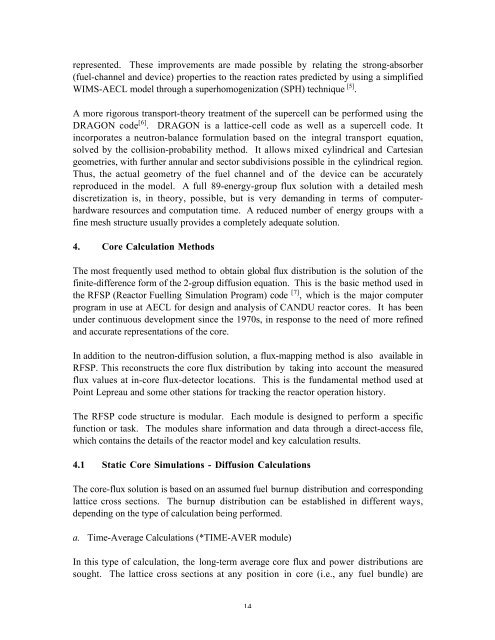Physics Codes and Methods for CANDU Reactor by ... - Basic Search
Physics Codes and Methods for CANDU Reactor by ... - Basic Search
Physics Codes and Methods for CANDU Reactor by ... - Basic Search
Create successful ePaper yourself
Turn your PDF publications into a flip-book with our unique Google optimized e-Paper software.
epresented. These improvements are made possible <strong>by</strong> relating the strong-absorber(fuel-channel <strong>and</strong> device) properties to the reaction rates predicted <strong>by</strong> using a simplifiedWIMS-AECL model through a superhomogenization (SPH) technique [5] .A more rigorous transport-theory treatment of the supercell can be per<strong>for</strong>med using theDRAGON code [6] . DRAGON is a lattice-cell code as well as a supercell code. Itincorporates a neutron-balance <strong>for</strong>mulation based on the integral transport equation,solved <strong>by</strong> the collision-probability method. It allows mixed cylindrical <strong>and</strong> Cartesiangeometries, with further annular <strong>and</strong> sector subdivisions possible in the cylindrical region.Thus, the actual geometry of the fuel channel <strong>and</strong> of the device can be accuratelyreproduced in the model. A full 89-energy-group flux solution with a detailed meshdiscretization is, in theory, possible, but is very dem<strong>and</strong>ing in terms of computerhardwareresources <strong>and</strong> computation time. A reduced number of energy groups with afine mesh structure usually provides a completely adequate solution.4. Core Calculation <strong>Methods</strong>The most frequently used method to obtain global flux distribution is the solution of thefinite-difference <strong>for</strong>m of the 2-group diffusion equation. This is the basic method used inthe RFSP (<strong>Reactor</strong> Fuelling Simulation Program) code [7] , which is the major computerprogram in use at AECL <strong>for</strong> design <strong>and</strong> analysis of <strong>CANDU</strong> reactor cores. It has beenunder continuous development since the 1970s, in response to the need of more refined<strong>and</strong> accurate representations of the core.In addition to the neutron-diffusion solution, a flux-mapping method is also available inRFSP. This reconstructs the core flux distribution <strong>by</strong> taking into account the measuredflux values at in-core flux-detector locations. This is the fundamental method used atPoint Lepreau <strong>and</strong> some other stations <strong>for</strong> tracking the reactor operation history.The RFSP code structure is modular. Each module is designed to per<strong>for</strong>m a specificfunction or task. The modules share in<strong>for</strong>mation <strong>and</strong> data through a direct-access file,which contains the details of the reactor model <strong>and</strong> key calculation results.4.1 Static Core Simulations - Diffusion CalculationsThe core-flux solution is based on an assumed fuel burnup distribution <strong>and</strong> correspondinglattice cross sections. The burnup distribution can be established in different ways,depending on the type of calculation being per<strong>for</strong>med.a. Time-Average Calculations (*TIME-AVER module)In this type of calculation, the long-term average core flux <strong>and</strong> power distributions aresought. The lattice cross sections at any position in core (i.e., any fuel bundle) are14
















